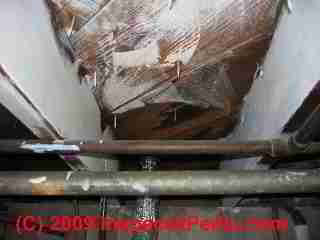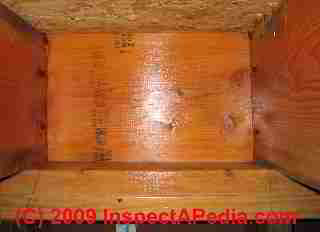 Mold Clearance Procedures After Mold Cleanup
Mold Clearance Procedures After Mold Cleanup
- POST a QUESTION or COMMENT about the criteria for a successful post mold cleanup job inspection & test
Mold clearance inspection & test procedure details.
Here we explain and describe in more detail the post remediation mold clearance procedures and testing that should be used after a mold remediation or mold cleanup project.
InspectAPedia tolerates no conflicts of interest. We have no relationship with advertisers, products, or services discussed at this website.
- Daniel Friedman, Publisher/Editor/Author - See WHO ARE WE?
Mold Remediation Clearance Procedures After a Mold Cleanup / Remediation Project
 This article is part of our series: the Mold Action Guide which provides an easy to understand step-by-step guide for
dealing with toxic or allergenic indoor mold and other indoor contaminants: what to do about mold "mildew," moisture, in
your house or office, building-related illness, involving your physician, treatment, sick building investigators, reduction of irritants, and special
products to help clean buildings and air.
This article is part of our series: the Mold Action Guide which provides an easy to understand step-by-step guide for
dealing with toxic or allergenic indoor mold and other indoor contaminants: what to do about mold "mildew," moisture, in
your house or office, building-related illness, involving your physician, treatment, sick building investigators, reduction of irritants, and special
products to help clean buildings and air.
Our page top photo shows a rather pro-forma application of fungicidal sealant paint at a mold remediation project. Given the evidence of half-hearted work during the relatively easy paint job we wondered about the care that had been taken during the more difficult physical cleaning of building surfaces.
Our next mold cleanup job photo (above-left) shows an immaculately and professionally cleaned section of building framing that had also been treated with a sealant spray.
There are no single accepted "pass-fail" criteria for clearance inspections.
- An expert performing a mold clearance inspection and "test" will examine remediated areas for mold or other allergens and
- S/he will also inspect other building areas for evidence of spread of contaminated demolition debris or inadequate cleaning if cleaning was recommended for those areas.
A professional onsite post-mold-remediation project clearance inspection and test combines a visual inspection of the extent of removal and cleaning of infected materials/areas with a microscopic examination of surface, dust, air, and/or vacuum samples collected at the property.
Visual Inspection for Demolition & Cleaning Completeness
A visual inspection is performed of both the cleaned area and other building areas.
Also see MOLD CLEARANCE TIMING.
In the clean-up area we want to know that demolition has been sufficient - that no moldy materials remain, and that all surfaces appear to have been physically cleaned. If a fungicidal sealant was to be applied, we want to see that it was not simply sprayed atop mold and dirt or debris instead of first cleaning those surfaces.
Mold Screening Tests for Effective Cleaning in the Work Area
The clearance inspector will collect mold clearance inspection test samples of physical surfaces which appear to still be moldy or dirty; if all surfaces are clean we will collect at least one settled dust sample from a representative cleaned surface in each major area. We may also collect other screening samples by using air or vacuum sampling methods.
Watch out: air sampling alone is not a reliable means of screening a building for problems.
Mold Screening Tests for Cross Contamination Outside of the Work Area
Outside of the remediation area we will collect screening samples of suspect surfaces, settled dust, vacuum and/or air samples of representative areas in the building, paying special attention to areas (or equipment such as HVAC systems) which are at particular risk of having been cross-contaminated by inadequate dust containment measures during the cleanup.
General Property Condition
The clearance inspector should also report ongoing conditions which continue to put the building at extra risk of a new mold problem, such as failure to correct various causes of leaks, water entry, and high moisture.
Lab Processing of Mold Clearance Test Samples
Test samples from the site examined in a qualified aerobiology, forensic, or environmental test laboratory using appropriate chemical/stain preparations and a light microscope at magnifications up to 1000X.
Our opinion and that of other microbiologists or aerobiologists regarding the level of cleanliness reflected by fungal samples is based on several existing studies of building contamination, a comparison with the original contamination levels, and our field and laboratory experience examining properties before and after remediation.
U.S. EPA Guidance for Mold Clearance Inspection After a Mold Cleanup
From the US EPA we include and comment on this more general advice on the criteria for a mold cleanup job: [Our comments are in brackets]
How Do I Know When the Remediation or Cleanup is Finished?
- You must have completely fixed the water or moisture problem before the cleanup or remediation can be considered finished.
See MOLD PREVENTION GUIDE - You should have completed mold removal. Visible mold and moldy odors should not be present. Please note that mold may cause staining and cosmetic damage.
See MOLD CLEANUP, VISUAL CHARACTERISTICS and
see ACCEPTABLE MOLD LEVEL.
Remember that no building is mold-free except perhaps inside of a manufacturing "clean room" - mold exists in air everywhere and small amounts of molds will be found in settled dust just about everywhere - don't set a target of "zero mold".] - You should have revisited the site(s) shortly after cleanup and it should show no signs of water damage or mold growth.
See MOLD CLEARANCE TIMING. - People should have been able to occupy or re-occupy the area without health complaints or physical symptoms.
See MOLD RELATED ILLNESS GUIDE. - Ultimately, this is a judgment call [and must include an understanding of the original location, extent, type, and cause of mold contamination that was to be removed as well as the chances of other mold contamination in the building that was not addressed]; there is no easy answer.
...
Continue reading at MOLD CLEARANCE TIMING or select a topic from the closely-related articles below, or see the complete ARTICLE INDEX.
Or see these
Mold Cleanup / Remediation Articles
- ACCURACY OF AIR TESTS for MOLD
- MOLD ACTION GUIDE
- MOLD CLEANUP COMPANIES
- MOLD CLEANUP GUIDE- HOW TO GET RID OF MOLD
- MOLD CLEARANCE: FOLLOWUP STEPS
- MOLD CLEARANCE INSPECTIONS
- MOLD CLEARANCE PROCEDURES when, where, and how a post mold remediation job inspection and test should be performed
- MOLD CLEARANCE TIMING
- ACCEPTABLE MOLD LEVEL
- MOLD CLEANUP, VISUAL CHARACTERISTICS
- MOLD LEVELS IN BUILDINGS
- MOLD CLEARANCE: FOLLOWUP STEPS
- MOLD CLEARANCE TEST, SUCCESSFUL
- MOLD / ENVIRONMENTAL EXPERT, HIRE ?
- MOLD INFORMATION CENTER - starting point for building mold contamination problems
- MOLD INSPECTORS & MOLD TESTERS
- MOLD PREVENTION GUIDE
- MOLD RESISTANT CONSTRUCTION
- WHEN TO STOP LOOKING FOR MOLD
Suggested citation for this web page
CLEARANCE PROCEDURES at InspectApedia.com - online encyclopedia of building & environmental inspection, testing, diagnosis, repair, & problem prevention advice.
Or see this
INDEX to RELATED ARTICLES: ARTICLE INDEX to BUILDING ENVIRONMENT
Or use the SEARCH BOX found below to Ask a Question or Search InspectApedia
Ask a Question or Search InspectApedia
Try the search box just below, or if you prefer, post a question or comment in the Comments box below and we will respond promptly.
Search the InspectApedia website
Note: appearance of your Comment below may be delayed: if your comment contains an image, photograph, web link, or text that looks to the software as if it might be a web link, your posting will appear after it has been approved by a moderator. Apologies for the delay.
Only one image can be added per comment but you can post as many comments, and therefore images, as you like.
You will not receive a notification when a response to your question has been posted.
Please bookmark this page to make it easy for you to check back for our response.
IF above you see "Comment Form is loading comments..." then COMMENT BOX - countable.ca / bawkbox.com IS NOT WORKING.
In any case you are welcome to send an email directly to us at InspectApedia.com at editor@inspectApedia.com
We'll reply to you directly. Please help us help you by noting, in your email, the URL of the InspectApedia page where you wanted to comment.
Citations & References
In addition to any citations in the article above, a full list is available on request.
- [1] "A Brief Guide to Mold, Moisture, and Your Home", U.S. Environmental Protection Agency US EPA - includes basic advice for building owners, occupants, and mold cleanup operations. See http://www.epa.gov/mold/moldguide.htm
- In addition to citations & references found in this article, see the research citations given at the end of the related articles found at our suggested
CONTINUE READING or RECOMMENDED ARTICLES.
- Carson, Dunlop & Associates Ltd., 120 Carlton Street Suite 407, Toronto ON M5A 4K2. Tel: (416) 964-9415 1-800-268-7070 Email: info@carsondunlop.com. Alan Carson is a past president of ASHI, the American Society of Home Inspectors.
Thanks to Alan Carson and Bob Dunlop, for permission for InspectAPedia to use text excerpts from The HOME REFERENCE BOOK - the Encyclopedia of Homes and to use illustrations from The ILLUSTRATED HOME .
Carson Dunlop Associates provides extensive home inspection education and report writing material. In gratitude we provide links to tsome Carson Dunlop Associates products and services.

